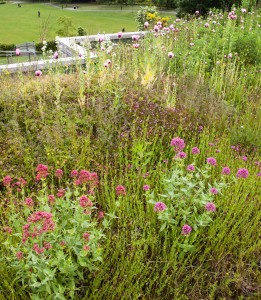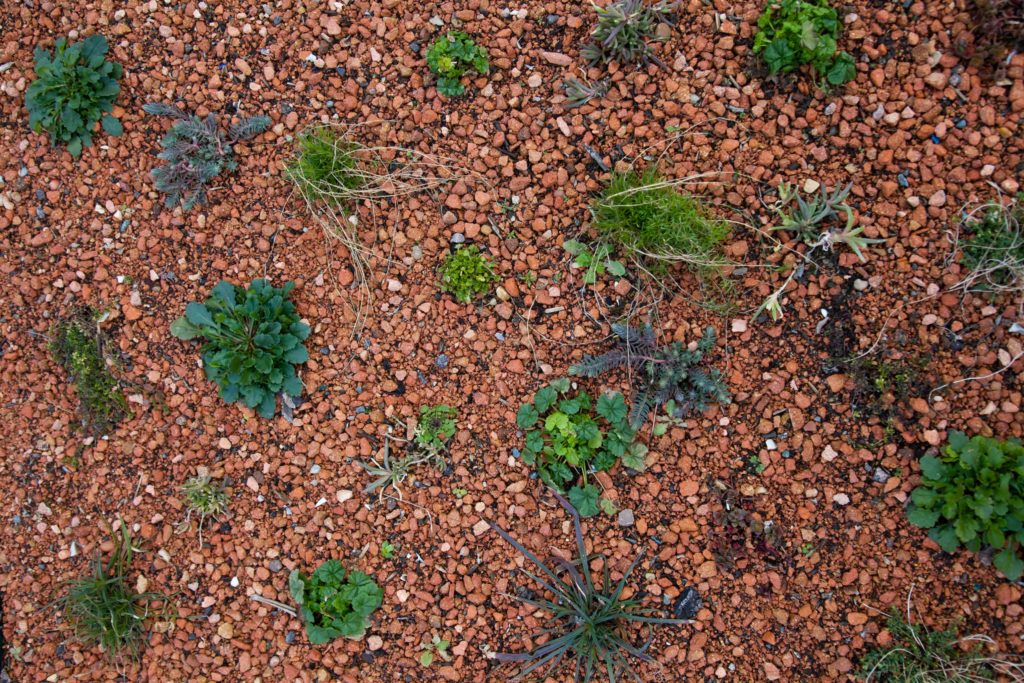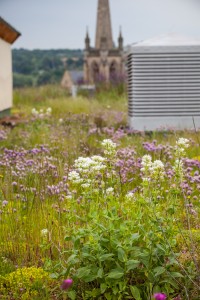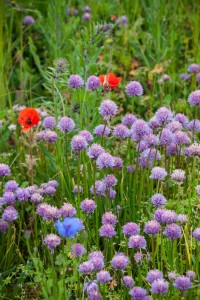Continuing in our series on roof gardens, this post is guest-written for us by Maggie Fennell of GreenSky, a nursery specialising in supply of plants and substrates for green roofs and which has joint research projects with University of Sheffield. Her contact details are at the end of the post.
All green roofs share certain challenges for the plants. From lightweight, extensive roofs to full scale roof gardens, they will be living in an artificial, sterile growing medium without the diverse soil ecology that supports plants in a more natural environment. Unlike ‘terrestrial’ planting, they have no access to the water table so they are completely reliant on rainfall and artificial irrigation. Add to this the extremes of temperature and wind exposure at roof height and it is clear we have a very challenging environment in which to plant.
Extensive, lightweight green roofs take on this challenge by using only the very toughest, most resilient plants which are naturally found in poor, shallow soils facing harsh conditions. This means wildflowers and hardy succulents such as sedums are most commonly used. At the other end of the spectrum intensive roof gardens provide increased structural loading and maintenance access to support a wide plant range from trees to turf lawns.

Sharrow School in Sheffield is a world class example of a green roof that is both biodiversity-driven and visually stimulating
In between these two extremes there is growing interest in ‘semi-intensive’ green roofs which support a much wider range of plants than the extensive roofs by providing 150-250mm depth of substrate and a modest maintenance burden. Hardy perennials and some small shrubs can be used to create a variety of ecologically diverse and visually attractive ‘roofscapes’ without the heavy loading requirements of an intensive roof.
To maximise the effectiveness of this kind of planting it is important to consider two main differences from ground level landscaping. The first is the survival of plants in these harsh conditions – how can losses be reduced? The idea of forming a healthy community of plants that mimic a natural ecosystem is not one that often arises in the realm of aesthetically driven amenity planting, but on the roof it is more important. The second is the changing viewpoint. Often there is not a ‘front’ or ‘back’ view, as green roofs might be overlooked from various angles rather than from the same level.

Randomised plant placement is the normal planting method on extensive roofs requiring minimal maintenance
The natural planting technique that results from both of these considerations is one that mixes up individual plants alongside different species in a mosaic-like form, rather than swathes of a single species. This randomised or ‘naturalistic’ arrangement of plants can seem quite foreign to landscapers used to working to precise planting schemes which carefully position plant structures and colours for a certain visual display.
One reason why the juxtaposition of varied species is helpful for green roof survival is related to how plants cope with the stresses of limited substrate depth. Different species have their own techniques for gaining the maximum moisture and nutrition from the limited supplies available on the roof. A sedum with shallow, fibrous roots will provide less competition to a neighbouring, relatively deep-rooting wild carrot. Plants can differ nearly as much below ground as above it, and the diverse root structures will exploit different levels of the substrate layer to the best effect.
This variation of plant performance also means that interspersed species show off their best colours in different seasons. The overall effect of a reasonably colourful carpet of vegetation is maintained throughout the year rather than having isolated patches that look great in spring but a bit bare in autumn.


The wet summer of 2012 was excellent for alliums on green roofs
An extension of this idea is that species react differently to the fluctuations in annual weather patterns. A particularly cold spring, an unusually harsh winter or an unseasonably wet summer might each have an adverse effect on particular types of plants. By combining many plant genera, the chances are that whatever record-breaking weather statistic should be quoted in a given year, a proportion of the species on your roof will be performing well, or enjoying an unexpected advantage. If those plants are mixed fairly evenly across the scheme they will serve to compensate for struggling neighbours, who may get to return the favour in future years.
This demonstrates how a community of plants work together in a way that reduces maintenance while maintaining a pleasing visual effect. Another example of this is resistance to pests and diseases which might have a noticeable effect on a large mono-culture, but less impact amongst varied species.
This ecosystem approach does not necessarily conflict with a designer’s artistic aspirations, it merely recognises the increased horticultural and practical requirements of the planting scheme. Plants can still be arranged according to flower or foliage colour if desired, and deeper substrate areas can provide anchorage for taller, more structural species. It is always important to consider the client’s expectations concerning both aesthetic effect and maintenance provision when designing a successful green roof – as they can both differ greatly from a ground level garden.
For more details or advice, look on the GreenSky website at www.boningale-greensky.co.uk or contact Maggie Fennell directly at [email protected]

